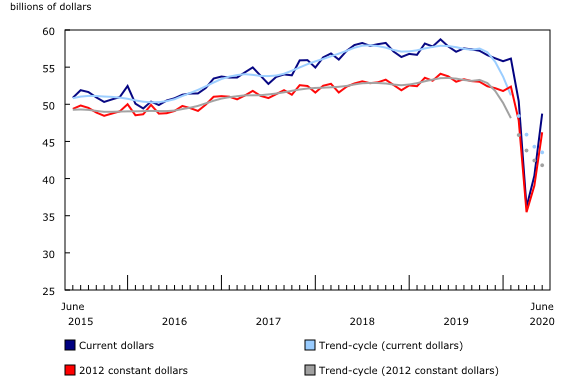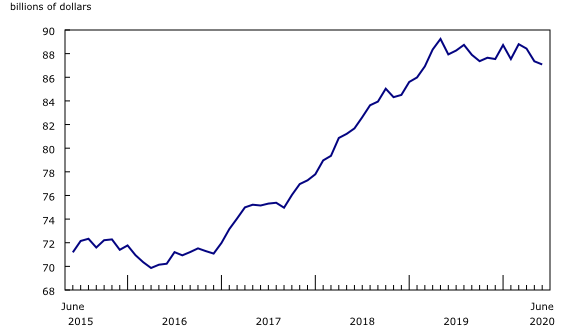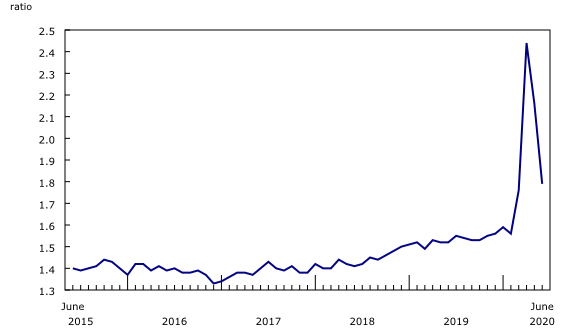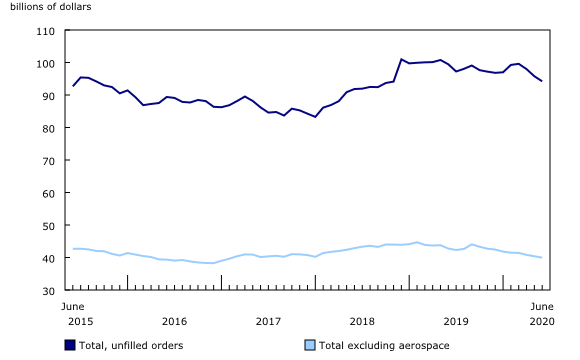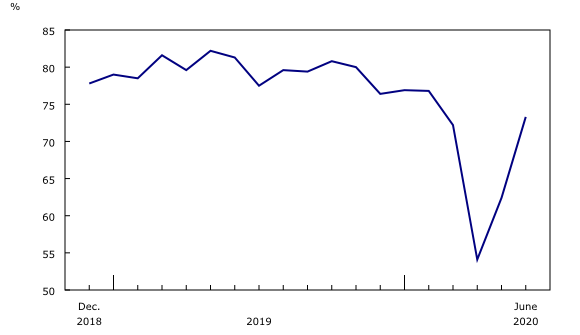Monthly Survey of Manufacturing, June 2020
Archived Content
Information identified as archived is provided for reference, research or recordkeeping purposes. It is not subject to the Government of Canada Web Standards and has not been altered or updated since it was archived. Please "contact us" to request a format other than those available.
Released: 2020-08-14
Manufacturing sales rose by a record 20.7% to $48.7 billion in June, following an 11.6% increase in May. Many factories operated at a much higher capacity in June, with the capacity utilization rate (not seasonally adjusted) for the total manufacturing sector increasing 10.9 percentage points to 73.3%. Consistent with the increase in sales and capacity utilization in June, the May reference month release of the Canadian Survey on Business Conditions indicated that almost one-fourth (23.9%) of manufacturers expected to increase their number of employees over the next three months. Still, the capacity utilization rate remained 8.0 percentage points below the June 2019 level (81.3%).
Sales were up in all 21 industries, led by the motor vehicle and motor vehicle parts industries. Excluding these two industries, manufacturing sales increased 10.3%. Nevertheless, total manufacturing sales in June were 13.2% below their pre-pandemic level in February.
In real (or volume) terms, manufacturing sales increased 18.4%, indicating a higher volume of products sold in June.
Large quarterly decreases for manufacturing sales
Total manufacturing sales decreased from $162.4 billion in the first quarter to $125.3 billion in the second quarter, a record 22.8% decline. The value of sales in the second quarter was at its lowest since the third quarter of 2009. In volume terms, manufacturing sales decreased 20.5% in the second quarter, mostly because of lower volumes sold in the transportation equipment (-50.6%) and petroleum and coal product (-28.5%) industries.
Manufacturers anticipated an 18.5% decrease in capital spending in 2020 (down to $18.1 billion from $22.1 billion) when compared with 2019, as reported in the revised intentions for non-residential capital and repair expenditures release. The decline in capital spending intentions may impact manufacturing capacity utilization in the future, as well as demand for machinery and equipment.
The impact of the pandemic on manufacturing sales
Based on respondent feedback, the largest estimated impacts of the pandemic on manufacturing sales in dollar terms were in the transportation equipment (-$1.1 billion), machinery (-$481 million), fabricated metal product (-$463 million), petroleum and coal product (-$385 million), food (-$319 million), and primary metal (-$260 million) industries. It should be noted that these estimates are on an unadjusted basis. However, they provide a snapshot of the magnitude with which the pandemic may have lowered sales.
Motor vehicles and motor vehicle parts account for more than half of the sales gain in June
Sales in the transportation equipment industry rose for the second consecutive month, more than doubling (+144.3%) to $8.8 billion in June. The largest increases were in the motor vehicle (+281.6%) and motor vehicle parts (+190.3%) industries, as most plants returned to full production following shutdowns earlier in the pandemic. Despite this monthly increase, sales of motor vehicles and motor vehicle parts were down by one-quarter (-24.4%) compared with June 2019.
Sales rose for the second consecutive month in the petroleum and coal product industry, up by almost one-third (+31.5%) to $3.3 billion in June. This increase reflects higher prices and volumes—refineries ramped up production in response to greater fuel demand as provinces across Canada continued to ease physical distancing measures and implement their economic recovery plans in June. Nevertheless, total sales of petroleum and coal products were down by almost half (-46.9%) compared with June 2019.
Sales rose by two-thirds (+66.8%) in the aerospace product and parts industry and by over one-quarter (+27.3%) in the plastics and rubber products industry.
Manufacturing sales also increased in the fabricated metal product (+9.9%), primary metal (+8.4%), wood product (+11.7%) and food (+2.3%) industries.
Sales rise in Ontario and Quebec
Manufacturing sales were up in eight provinces in June, with Ontario and Quebec accounting for 92.4% of the national increase.
Sales in Ontario increased for the second consecutive month, up by more than one-third (+35.8%) to $22.5 billion in June. Sales increased in 18 of 21 industries, led by the motor vehicle (+288.9%), motor vehicle parts (+200.7%), plastics and rubber products (+33.8%), petroleum and coal product (+35.8%), fabricated metal product (+18.5%), and primary metal (+16.3%) industries.
In Quebec, manufacturing sales were up for the second consecutive month, rising 16.9% to $12.5 billion in June. Sales increased in 19 of 21 industries, led by the transportation equipment, petroleum and coal product, plastics and rubber products, and primary metal industries.
Sales were down in Manitoba (-1.7%) and Prince Edward Island (-7.2%), mainly because of lower sales of durable goods.
Manufacturing sales increase in the census metropolitan areas of Toronto and Montréal
On an unadjusted basis, manufacturing sales rose in 10 of the 12 census metropolitan areas covered by the survey in June, led by Toronto (+37.6%) and Montréal (+32.0%).
In Toronto, the increase in the transportation equipment industry (+197.3%) was mostly attributable to motor vehicles and motor vehicle parts.
In Montréal, higher sales of transportation equipment (+88.5%) and primary metals (+63.3%) drove the growth in June.
Manufacturing sales in Regina were down 14.3%, mostly because of lower seasonal sales in the chemical industry.
Inventory levels decrease
Inventory levels declined for the third consecutive month, decreasing 0.3% to $87.1 billion in June. Inventories were down in 14 of 21 industries, led by the fabricated metal product (-7.4%), primary metal (-4.3%), transportation equipment (-1.4%) and wood product (-4.3%) industries. These decreases were partly offset by a 21.5% increase in petroleum and coal product inventories.
The inventory-to-sales ratio declined from 2.16 in May to 1.79 in June. This ratio measures the time, in months, that would be required to exhaust inventories if sales were to remain at their current level.
Unfilled orders decline
Total unfilled orders for the manufacturing sector declined 1.6% to $94.2 billion, the third consecutive monthly decrease. Overall, unfilled orders were down in 8 of 21 industries, with the largest decreases in the transportation equipment and fabricated metal product industries.
This was partially offset by higher unfilled orders in the primary metal, chemical, and plastics and rubber products industries.
New orders rose for the second straight month, up 23.6% to $47.2 billion in June—mostly on higher orders of transportation equipment.
Capacity utilization rate increases
The capacity utilization rate (not seasonally adjusted) for the total manufacturing sector rose from 62.4% in May to 73.3% in June.
The capacity utilization rate for durable goods rose 17.0 percentage points to 70.8%, mostly attributable to higher production at motor vehicle assembly and motor vehicle parts plants after some of these plants were shut down as a result of the pandemic in May.
The capacity utilization rate for non-durable goods rose 4.2 percentage points to 76.1% in June, partly reflecting ramped up production of plastics and rubber products.
Sustainable development goals
On January 1, 2016, the world officially began implementing the 2030 Agenda for Sustainable Development—the United Nations' transformative plan of action that addresses urgent global challenges over the next 15 years. The plan is based on 17 specific sustainable development goals.
The Monthly Survey of Manufacturing is an example of how Statistics Canada supports the reporting on the global sustainable development goals. This release will be used to help measure the following goal:

Note to readers
While the quality of this month's data remains high, response rates from manufacturers have fallen from the usual 95% to a rate of 86% in June. Every effort has been made to supplement this month's data with information from other sources.
Monthly data in this release are seasonally adjusted and are expressed in current dollars unless otherwise specified.
Seasonally adjusted data are data that have been modified to eliminate the effect of seasonal and calendar influences to allow for more meaningful comparisons of economic conditions from period to period. For more information on seasonal adjustment, see Seasonally adjusted data – Frequently asked questions.
Trend-cycle estimates are included in selected charts as a complement to the seasonally adjusted series. These data represent a smoothed version of the seasonally adjusted time series and provide information on longer-term movements, including changes in direction underlying the series. For information on trend-cycle data, see Trend-cycle estimates – Frequently asked questions.
Both seasonally adjusted data and trend-cycle estimates are subject to revision as additional observations become available. These revisions could be large and could even lead to a reversal of movement, especially for reference months near the end of the series or during periods of economic disruptions.
Non-durable goods industries include food, beverage and tobacco products, textile mills, textile product mills, clothing, leather and allied products, paper, printing and related support activities, petroleum and coal products, chemicals, and plastics and rubber products.
Durable goods industries include wood products; non-metallic mineral products; primary metals; fabricated metal products; machinery; computer and electronic products; electrical equipment, appliances and components; transportation equipment; furniture and related products; and miscellaneous manufacturing.
Production-based industries
For the aerospace and shipbuilding industries, the value of production is used instead of the value of sales of goods manufactured. The value of production is calculated by adjusting monthly sales of goods manufactured by the monthly change in inventories of goods in process and finished products manufactured. The value of production is used because of the extended period of time that it normally takes to manufacture products in these industries.
Unfilled orders are a stock of orders that will contribute to future sales, assuming that the orders are not cancelled.
New orders are those received, whether sold in the current month or not. New orders are measured as the sum of sales for the current month plus the change in unfilled orders from the previous month to the current month.
Manufacturers reporting sales, inventories and unfilled orders in US dollars
Some Canadian manufacturers report sales, inventories and unfilled orders in US dollars. These data are then converted to Canadian dollars as part of the data production cycle.
For sales, based on the assumption that they occur throughout the month, the monthly average exchange rate for the reference month established by the Bank of Canada is used for the conversion. The monthly average exchange rate is available in table 33-10-0163-01. Inventories and unfilled orders are reported at the end of the reference period. For most respondents, the noon spot exchange rate on the last working day of the month is used for the conversion of these variables.
However, some manufacturers choose to report their data as of a day other than the last day of the month. In these instances, the daily average exchange rate on the day selected by the respondent is used. Because of exchange rate fluctuations, the daily average exchange rate on the day selected by the respondent can differ from both the exchange rate on the last working day of the month and the monthly average exchange rate. Daily average exchange rate data are available in table 33-10-0036-01.
Revision policy
Each month, for the Monthly Survey of Manufacturing, preliminary data are released for the reference month and revised data are released for the three previous months. Revisions are made to reflect new information provided by respondents and updates to administrative data.
Once per year, a revision project is undertaken and data for several years are revised.
Real-time data tables
Real-time data tables 16-10-0118-01, 16-10-0119-01, 16-10-0014-01 and 16-10-0015-01 will be updated on August 25.
Next release
Data from the Monthly Survey of Manufacturing for July will be released on September 15.
Contact information
For more information, or to enquire about the concepts, methods or data quality of this release, contact us (toll-free 1-800-263-1136; 514-283-8300; STATCAN.infostats-infostats.STATCAN@canada.ca) or Media Relations (613-951-4636; STATCAN.mediahotline-ligneinfomedias.STATCAN@canada.ca).
- Date modified:




